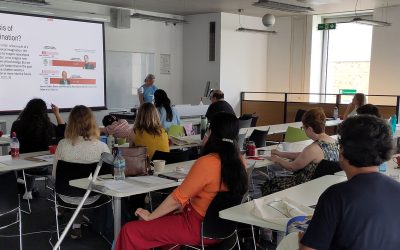Date: 10 June 2014 Time: 1.30pm to 7.00pm
Venue: Lancaster University Conference Centre
The Annual CeMoRe Research event will follow on from Rachel Aldred’s workshop.
Programme (8 May2014)
Free lunch – for speakers and audience – you MUST register with Pennie Drinkall
Each speaker has a 20 minute slot. Talk for 10-15 minutes followed by 5-10 minutes discussion. These timing will be strictly adhered to. Brief presentations MUST be sent in advance to p.drinkall@lancaster.ac.uk. The talk should be modelled on a TED talk and must NOT seek to summarise whole books or whole PhDs…
1.30-2.30pm MIGRATION AND MOBILITIES
Chair: James Faulconbridge
Zana Vathi, Edge Hill University: Tales of a midsummer day: experiences of locality and (super) diversity of the Albanian origin teenagers upon their families’ return to Saranda
In this paper, the experiences of Albanian-origin teenagers whose families returned to Albania from Greece are analysed in relation to the temporal (super)diverse characteristics of the context in which they have relocated, and the concepts of stasis, mobility and time. Summers bring to Saranda internal and international tourists, visitors and migrants, changing the demography, the mobility patterns, and the urban landscape. Findings show that the characteristics of the urban space and the temporal aspects of diversity affect teenagers’ settlement, identification and belonging, which show seasonal and temporal dimensions.
Abhirarm Chandrasen, Marketing Lancaster: Home is where the heart is. Home countries and their influences on sojourners’ consumption preferences
In an increasingly interconnected world, more and more consumers are leaving their home countries to take-up temporary residence abroad (IOM, 2005). This group of transnational travellers are known as the sojourners (Gullekson and Vancouver, 2010). Despite the recognition of this phenomenon, research on sojourners’ consumption practices has largely been neglected (Bardhi et al, 2012; Sirkeci, 2013). To address this gap, a study on the influence of home countries on international student sojourners (N = 176) was conducted. It was found that their home countries were indeed influential toward consumption practices during their temporary stay in the host country.
Hania Janta, Surrey, ‘Female Migrant Architects in Basel and their Visits Home’ University of Surrey, h.janta@surrey.ac.uk
Technological and transport changes, combined with revisions to immigration policies, are impacting on the frequency and ways the migrants maintain their relationships with family and friends at home. This presentation will outline a project that aims to look at migrant women working as architects in Basel, Switzerland in order to explore the experiences of migrants’ visits home and ways they maintain relationships with their friends and families. By employing in-depth interviews with migrant women, this project will shed light on factors that frame access to various home visits options and experiences.
2.30-4.05pm DESIGNING NEW MOBILITIES
Chair: Jen Southern
Walter Goettlich, Concordia, My Other Ride is a… Systems of Surveillance & Invitations to Imagination on the American Interstate Highway.
Along its 45,000 miles, the network of American interstate automobility comprises a number of interpenetrating, schematic/schematizing techno-cultural subsystems that include automated tollbooths, electronic financial transactions and position-aware technologies. These systems ease passage, but also enhance surveillance. Non-systemic gaps persist—bumper stickers amongst others—opening possibilities for the driving subject to be ‘seen’ that do not entail surveillance systems. Such spaces, which require the attention and imagination of other drivers, are at once material and discursive; real and virtual; subjectifying and liberating; interstitial and yet produced through and informed by the dominant cultural systems and logics between which they are situated.
Elisa Serafinelli, Social Sciences, Hull: Instagram is changing the Traditional Concepts of Identity, Memory and Information toward New Mobile Visualities. serafinelli@2011.Hull.ac.uk
The escalation of photo sharing through social networking sites is the most substantial change within the interaction of mobile communication practices in recent years. My study analyses how Instagram (a photo sharing app) is determining a new conception of visual communications. Through the action of sharing, friending, liking and following it is generating also new social connections. The ever-present presence of smart phones combined to the power of the publicity of the everyday afforded by platforms like Instagram, is fostering the convergent notion of mobile visual communication that the concept of ‘being-as-mediated’ (Kember & Zylinska, 2012: 40) makes the difference in approaching the rise of visual relationships.
Cath Smith, Otago: How feasible and acceptable are Mobile Methods for collecting and analysing data about dog-walking and health?
To date, studies about dog-walking and health comprise both quantitative and qualitative methodologies. Qualitative methods have included face-to-face interviews and focus group discussions with humans. We wondered whether Mobile Methods might better capture perceptions of dog-walking and health as, unlike more traditional data collection methods, the interviewer is given the opportunity to gather elements of data other than the spoken word. We joined eleven healthy adults and their dogs for a walk-along interview. Memory triggers, human-dog interactions, and environmental connections provided enriched qualitative data. Our experiences also helped us to develop practical recommendations for future Mobile Method studies about dog-walking in both healthy adults and adults with long-term health conditions. BRIEF VIDEO
Discussant: Ole B Jensen
4.05-4.30 Tea /coffee/cakes
4.30- 6.05pm MOBILITY PRACTICES
Chair: Monika Buscher
Lynne Pearce, English & Creative Writing, Lancaster: Driving-as-event: literary excursions in automotive consciousness
In this paper I draw upon a small selection of literary texts – most of them written during the first decades of the twentieth-century – in order to reconceptualise our journeys made by car as unique events defined not only by generic utility (e.g., the commute, the weekend-drive, the road-trip), but also by the complex synthesis of perceptual, cognitive and affective processes that inhere in a one-off event that is (in its totality) effectively non-repeatable.
Bruna Vendemmia, Politecnico of Milan; The practices and spaces of new mobility in Italy: observing simultaneous lives. bruna.vendemmia@mail.polimi.it
This paper aims to study the rise of new mobility practices in Italy and their consequences on spatial transformations through the use of in-depth interviews to high mobile people and travel along experiences. The development of new mobility practices in recent years generated radical changes on territorial use and engendered novel spaces, especially involving a multi-territorialisation in the relation between individual and space. We use interviews as a tool to study urban transformations at macro, meso and micro scales and to describe the configuration of these new spaces, starting from a user perspective.
Noel Cass, James Faulconbridge, DOW&T, Lancaster: Mobility and spatio-temporality of practice: implications for low carbon mobility futures, n.cass1@lancaster.ac.uk
Theories of social practice advance understanding of mobility and the challenges of societal transition to bus, cycling and walking. In this paper we develop their understandings of how mobility connects together different sites of valued practices, with the timing and sequencing of activities at these sites and the distances between them being crucial in determining whether non-car based alternative low carbon mobilities are feasible. Our analysis suggests the need to consider not just transport but also the spatiality and temporality of the practices connected through it in a holistic low carbon mobility transition.
Cosmin Popan, Sociology, Lancaster: Effective or affective cycling? Bicycle mobilities and inclusiveness
Cycling’s aim to become a generalized urban mobility practice is caught today in a dilemma of fast versus slow. There is a tension between the imperative of ‘speed’ and efficiency which asks transportation infrastructure to confine cycling to the rhythm of effective ‘vehicular traffic’, and the stringency for ‘slower’ bicycles, who need to ‘gear down’ a speed or two from ordinary racing and sport configurations if they are to have broader affective resonance. This presentation compares the subcultures of ‘fast MAMILS’ (middle-aged men in lycra) and ‘slow hipsters’, and considers how their respective fashion statements might lead the way to more effective and/or affective cycling.
Discussion: Rachel Aldred
6.05pm onwards: Buffet Supper




